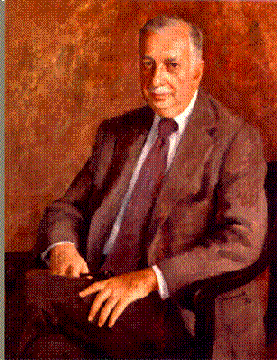Related Research Articles

Pediatrics also spelled paediatrics, is the branch of medicine that involves the medical care of infants, children, adolescents, and young adults. In the United Kingdom, pediatrics covers many of their youth until the age of 18. The American Academy of Pediatrics recommends people seek pediatric care through the age of 21, but some pediatric subspecialists continue to care for adults up to 25. Worldwide age limits of pediatrics have been trending upward year after year. A medical doctor who specializes in this area is known as a pediatrician, or paediatrician. The word pediatrics and its cognates mean "healer of children", derived from the two Greek words: παῖς and ἰατρός. Pediatricians work in clinics, research centers, universities, general hospitals and children's hospitals, including those who practice pediatric subspecialties.

Thomas Berry Brazelton was an American pediatrician, author, and the developer of the Neonatal Behavioral Assessment Scale (NBAS). Brazelton hosted the cable television program What Every Baby Knows, and wrote a syndicated newspaper column. He wrote more than two hundred scholarly papers and twenty-four books.
Janeway is a surname. Notable people with the surname include:
Judith Swann Palfrey is an American pediatrician and author. She is the T. Berry Brazelton Professor of Pediatrics at Harvard Medical School and the author of Community Child Health: An Action Plan for Today (1995) and Child Health In America: Making A Difference Through Advocacy (2006), and co-editor of Global Child Health Advocacy (2014) and the Disney Encyclopedia of Baby and Childcare (1995). She is also the former Faculty Dean of Adams House at Harvard University along with her husband Sean Palfrey who is also a pediatrician in Boston.
William Berenberg, M.D. was an American physician, Harvard professor, and pioneer in the treatment and rehabilitation of cerebral palsy.

Theodore Caldwell Janeway was the first full-time professor of medicine at the Johns Hopkins University School of Medicine, recruited in 1914.
Charles Alderson Janeway, Jr. (1943–2003) was an American immunologist who helped create the modern field of innate immunity. A member of the National Academy of Sciences, he held a faculty position at Yale University's Medical School and was an Howard Hughes Medical Institute Investigator.

The Janeway Children's Health and Rehabilitation Centre is a children's hospital located in St. John's, Newfoundland and Labrador, Canada.
Ralph David Feigin was an American pediatrician whose influential book Textbook of Pediatric Infectious Diseases was in its sixth printing at the time of his death.
Michael Shannon was an American pediatric toxicologist who specialized in the effect of toxins and poisonous substances in children. A dancer since his days in college, Shannon was known as the "dancing doctor".
Allan Macy Butler (1894–1986) was an American pediatrician and Chief of the Children's Medical Services at Massachusetts General Hospital and a professor of Pediatrics at Harvard Medical School. A pioneer in health services, Butler sought to change the structure of the American "fee-for-service" system of health care to one based on government-paid medical care for the elderly and low-income people.

Edward Gamaliel Janeway was an American physician who served as Health Commissioner of New York, and as president of the New York Medical Journal Association in the late nineteenth century. He was considered "one of America's premier internists in the late nineteenth and early twentieth centuries".

Alexander Sandor Nadas was a Hungarian-American pediatric cardiologist and Professor of Pediatrics at Harvard Medical School. He founded the cardiology program at Boston Children's Hospital, which was one of the early training programs in pediatric cardiology. Nadas authored an influential textbook, now known as Nadas' Pediatric Cardiology.
Clement Andrew Smith was an American pediatrician and the editor-in-chief of the journal Pediatrics. Though he did not consider himself to be a neonatologist, much of his work concerned the care of the newborn infant. He was associated with Harvard Medical School for several decades and served a term as president of the American Pediatric Society.
Edwards A. Park was an American pediatrician who established the pediatric heart disease clinic at the Johns Hopkins Hospital, along with other pediatric subspecialties. During his career, Park was Chief of Pediatrics at the Harriet Lane Home for two decades, and published articles on medical conditions such as rickets and lead poisoning. The contemporary pediatric department at Hopkins is still regulated in the same way that Park established. The Edwards A. Park Scholarship Fund at Johns Hopkins was built under his name upon his eightieth birthday by friends, colleagues and former students.

Rustin McIntosh was an American pediatrician. From 1930 until 1960, he was the chief of pediatrics at the Babies Hospital of NewYork–Presbyterian Hospital and the Reuben S. Carpentier Professor of Pediatrics at Columbia University. He received the John Howland Award in 1961.

Sallie Robey Permar is the pediatrician-in-chief at NewYork-Presbyterian / Weill Cornell Medical Center and the chair of the Department of Pediatrics at Weill Cornell Medicine. Her research focuses on infections affecting newborns.
Harvey Louis Levy is an American biochemical geneticist, pediatrician, physician scientist and academic. He is Senior Physician in Medicine and Genetics at Boston Children’s Hospital and Professor of Pediatrics at Harvard Medical School.
Daniel Cody Darrow was an American pediatrician and clinical biochemist whose research focused on fluid and electrolyte balance in the human body. He pioneered the routine use of intravenous potassium in patients after surgery, and in children with diarrhea.
References
- 1 2 3 4 Haggerty, RJ, and Lovejoy Jr., FH.(2007) Charles A. Janeway: Pediatrician to the World's Children Cambridge, Massachusetts: Harvard University Press. ( ISBN 978-0674023802)
- ↑ Marrie, Thomas J. (February 2008). "Osler's Nodes and Janeway Lesions". The American Journal of Medicine. 121 (2): 105–106. doi:10.1016/j.amjmed.2007.07.035. PMID 18261495 . Retrieved 29 December 2018.
- ↑ "YALE TAP DAY HELD; 10 REFUSE ELECTION". New York Times. 16 May 1930.